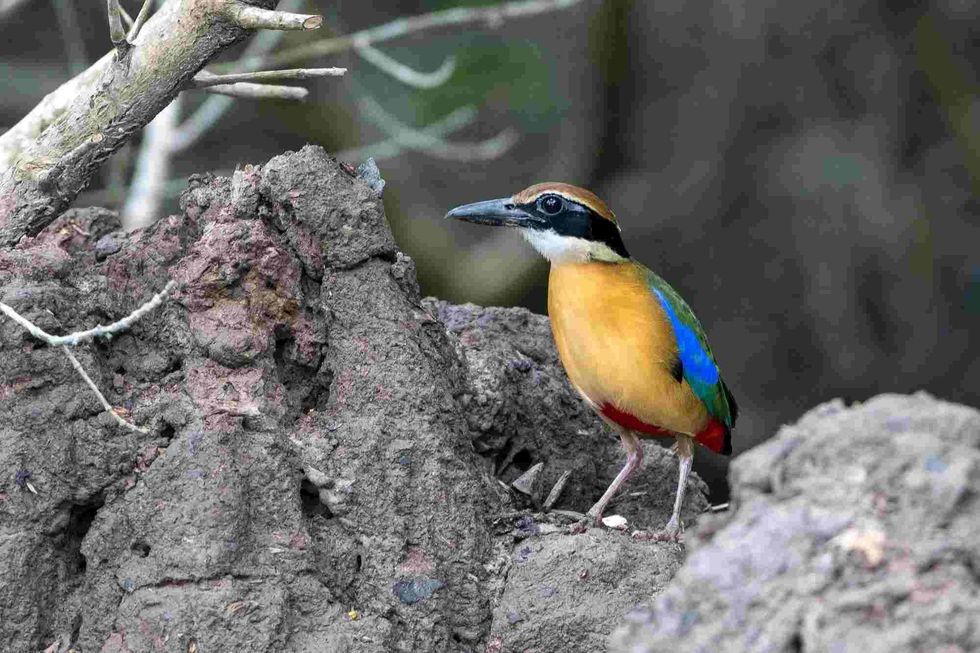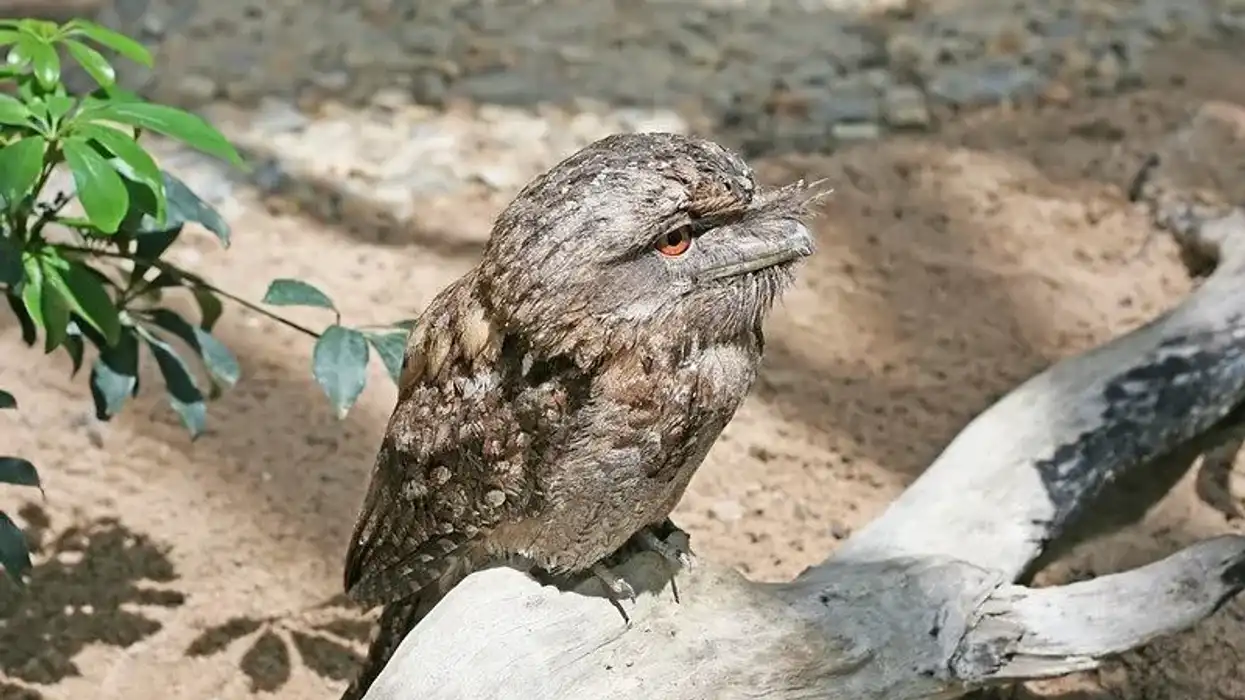The Pitta megarhyncha ranks first in our list of underrated birds! Hermann Schlegel, a German ornithologist, described the mangrove pitta for the first time in 1863.
The species' scientific name originated from Greek words, the first part meaning 'big' and 'rhynchos' meaning 'beak'. As a result of its dwindling population, this species has been difficult to examine through the years.
Both juvenile and adult mangrove pittas are believed to have identical coloration, with the exception that younger birds are somewhat duller. Since the Indian pitta, the blue winged pitta, and the mangrove pitta are very similar, they are said to be related species.
According to the IUCN, their conservation status is Near Threatened. In India, the mangrove pitta range extends from Bangladesh to the Malay Peninsula.
This bird is also is a rare inhabitant in Singapore. This bird is also known as the larger blue winged pitta and the Malay pitta.
If you like this fact article on mangrove pittas, don't forget to check out these other articles on shoebill facts and great green macaw facts.
Mangrove Pitta Interesting Facts
What type of animal is a mangrove pitta?
The mangrove pitta is a type of passerine bird that belongs to the Pittidae family.
What class of animal does a mangrove pitta belong to?
The Pitta megarhyncha is a member of the class Aves of the Animalia kingdom.
How many mangrove pittas are there in the world?
The population size of the Pitta megarchyna species is unknown. This species has a small population in general since their distribution does not span a large range and they are constrained to certain locations and habitats.
As per the IUCN Red List, the already sparse population size is said to be shrinking even faster due to habitat destruction. The size of resident occurrence is 648651.6 sq mi (1,680,000 sq km).
Where does a mangrove pitta live?
India, Thailand, Bangladesh, Singapore, Malaysia, Indonesia, and Myanmar are home to the mangrove pitta species. Their distribution is widespread in the Sundarban mangrove forests in India and Bangladesh.
The western coastlines of Myanmar, the Thai Peninsula, and regions in Malaysia are also home to this species. This blue-winged bird is also a resident on the eastern coast of Sumatra, Indonesia, and a rare resident in Singapore.
What is a mangrove pitta's habitat?
The natural habitat of this species covers tropical and sub-tropical mangroves in India. These birds are greatly threatened by habitat loss. Rivers, canals, deltas, tropical and subtropical swamps, and coastal forests are also amongst their habitats.
Who do mangrove pittas live with?
The mangrove pitta may live alone or sometimes in couples. They are only observed as a family during the breeding season. They demarcate their area to prevent their peers from entering it.
How long does a mangrove pitta live?
There hasn't been enough research to accurately assess the lifespan of this species. According to some reports, the average generation length is just over four years.
How do they reproduce?
To reproduce these birds lay eggs. The breeding season of the mangrove pitta species varies marginally across the Indian subcontinent and Asia.
In the former, the breeding season begins in April and lasts until mid-August, whereas in the latter, it begins in April and lasts until mid-June. Their eggs are deposited in a dome-shaped nest with a side entrance. Each clutch contains four to five light-colored eggs.
After roughly two weeks of incubation, the eggs hatch. After this, the newly fledged hatchling birds make local movements within their range in search of food.
What is their conservation status?
As per IUCN reports of 2016 the conservation status of the mangrove pitta is Near Threatened. Sadly, this bird will likely be placed in the Threatened category within the next few years.
This is because there is a steady rapid decline in the population size of this species due to habitat loss. Immediate conservation measures must be enforced to prevent this.
Mangrove Pitta Fun Facts
What do mangrove pittas look like?
The mangrove pitta is a small colorful terrestrial bird. This bird has a short tail and a robust bill and many of them have feathers that are richly colored. The Pitta megarhyncha is characterized by a brown crown, a green back, and a white chin.
The head is black, and the cloacal lips are crimson. These birds also have brown bellies with yellow highlights. Because of the similarity between the mangrove pitta and blue winged pitta, they are frequently confused.
How cute are they?
The beauty of this multicolored bird is underrated, owing to its rarity (Near Threatened). They are quite difficult to spot in the wild.
How do they communicate?
The Pitta megarhyncha species communicates by calling. These birds may frequently be sighted calling from the tops of mangrove trees and they also use body language as a means of communication. They are vocal birds whose call notes and lengths depend upon the nature of the situation.
How big is a mangrove pitta?
The mangrove pitta is 7.1–8.3 in (18-21 cm) in length. This species the similar in size to the blue-winged pitta, except it has a bigger head.
How fast can a mangrove pitta fly?
The precise speed at which these birds fly is unclear. Pitta megarhyncha birds are found at altitudes ranging from 0-3937 in (0-10,000 cm). This bird can be seen traveling at medium heights.
How much does a mangrove pitta weigh?
The mangrove pitta weighs 0.19-0.26 lb (0.09-0.12 kg). It is two times heavier than the hummingbird.
What are the male and female names of the species?
There are no specific names for male and female birds of this species. Both male and female birds are called mangrove pitta or Malay pitta birds.
What would you call a baby mangrove pitta?
A baby mangrove pitta may be called a mangrove pitta hatchling.
What do they eat?
They are seen foraging on the mangrove forest floor for food. A major part of their diet is mollusks and they also enjoy food like beetles, crustaceans, insect larvae, termites, and crabs.
Are they friendly?
These birds are less secretive than other pitta species. However, they do not engage in any form of human interaction. Pitta megarhyncha birds are not aggressive, they simply prefer to be alone in their own little world.
Would they make a good pet?
Pittas, in general, do not make good pets. Humans are unable to meet their natural environment and diet preferences. This bird requires more room, especially during the breeding season. As a result, it is difficult to live with these birds in our surroundings.
Did you know...
The mangrove pitta has powerful bills that can even shatter a crab.
Amongst tourists taking part in birding tours, this bird is popularly known as the 'Queen of Bhitarkanika'.
This species is monogamous and nonmigratory. It only travels short distances within local areas, after which it rests on trees.
What is the call of the mangrove pitta?
The call of the mangrove pitta is loud and perceptible. These birds produce a characteristic 'wieu wieu' sound. These calls are intended to either allure the opposing sex or to warn fellow mates to avoid their range.
Comparison with other pittas
Mangrove pitta and blue winged pitta birds are very similar, however, the blue-winged pitta has a slightly large and round belly while the mangrove pitta's belly is narrow. Both birds have black eye masks, which in the case of the former is thick and in the case of the latter is narrow at the end.
The mangrove pitta has a much longer bill.
When it comes to mangrove pitta and Indian pitta birds, the mangrove pitta's head crown is brown with a larger eye mask and no patch below the eye. Its head is somewhat protruded.
On the other hand, the head crown of an Indian pitta is tawny with a white patch below the eye. Their head is short and stubby. All three are super species due to the wide range of similarities shared.
Here at Kidadl, we have carefully created lots of interesting family friendly animal facts for everyone to discover! Learn more about some other birds from our lyrebird facts and common blackbird facts pages.
You can even occupy yourself at home by drawing one of our free printable mangrove pitta coloring pages.









